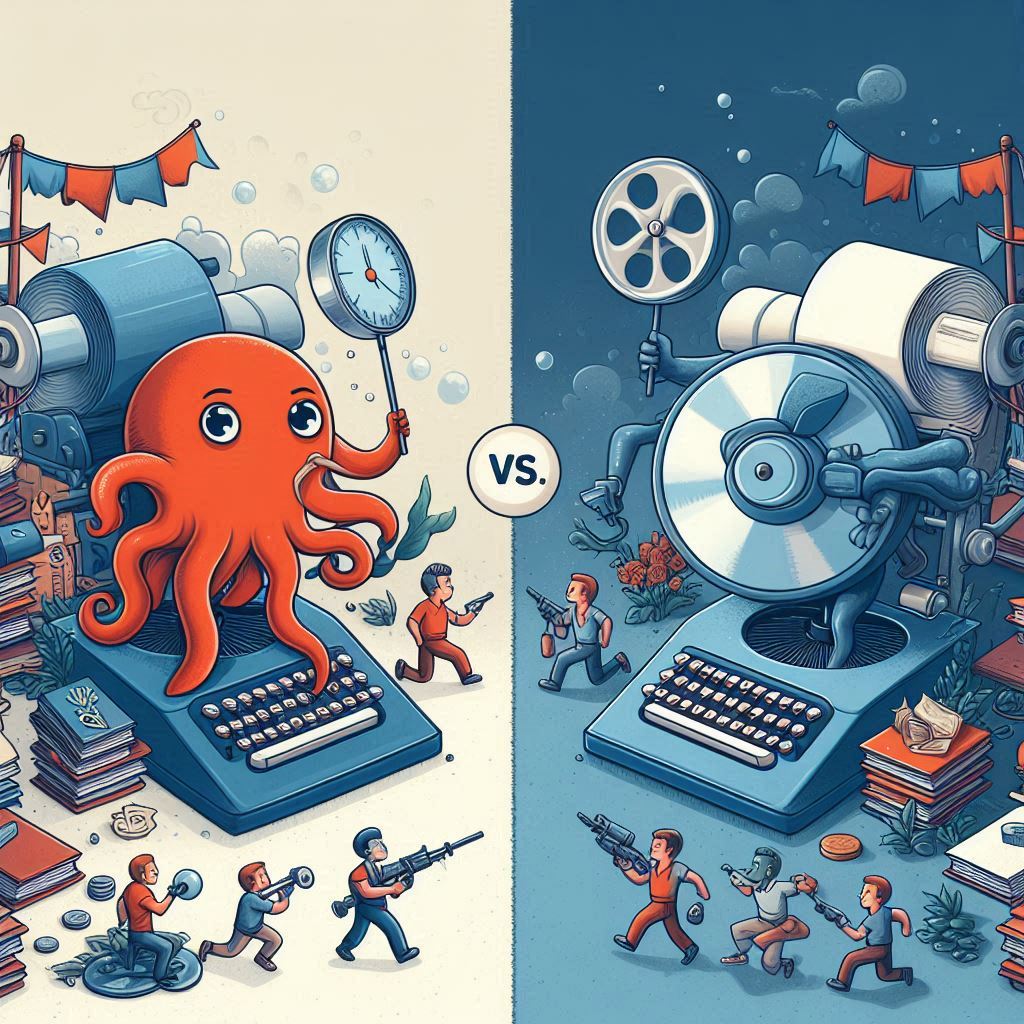Introduction
Choosing between self-publishing and traditional publishing is a critical decision for any aspiring author. Both routes have their own advantages and challenges, and the right choice depends on your goals, resources, and personal preferences. This blog explores the key differences between self-publishing and traditional publishing, highlighting the pros and cons of each to help you decide which path is best for you.
Self-Publishing
Overview
Self-publishing allows authors to publish their books independently, without the involvement of a traditional publishing house. Authors have full control over the entire process, from writing and editing to marketing and distribution.
Pros of Self-Publishing
Creative Control
Self-publishing gives you complete control over your content, cover design, pricing, and marketing strategies. You can make all the decisions regarding your book without interference.
Higher Royalties
Authors typically earn higher royalties through self-publishing compared to traditional publishing. While traditional publishers offer royalties ranging from 5% to 15%, self-published authors can earn up to 70% of the book’s sales price.
Faster Time to Market
The self-publishing process is generally faster than traditional publishing. You can publish your book as soon as it’s ready, without waiting for approval or dealing with long production schedules.
Access to Global Markets
Self-publishing platforms like Amazon Kindle Direct Publishing (KDP) and Smashwords allow you to distribute your book worldwide. You can reach a global audience with ease.
Cons of Self-Publishing
Upfront Costs
Self-publishing often requires upfront investment in editing, cover design, formatting, and marketing. These costs can add up quickly, and there’s no guarantee of a return on investment.
Time-Consuming
Managing the entire publishing process yourself can be time-consuming. You’ll need to handle everything from writing and editing to marketing and distribution.
Marketing Responsibility
As a self-published author, you’ll be responsible for all marketing efforts. This can be challenging if you lack experience in book promotion and marketing strategies.
Limited Bookstore Presence
Self-published books may have limited access to brick-and-mortar bookstores. Traditional publishers often have established relationships with bookstores, making it easier for their books to be stocked.
Traditional Publishing
Overview
Traditional publishing involves submitting your manuscript to a publishing house, which then handles the editing, design, production, and distribution of your book. If accepted, the publisher covers the costs and pays the author an advance and royalties.
Pros of Traditional Publishing
Professional Editing and Design
Traditional publishers provide professional editing, cover design, and formatting services. This ensures your book meets high industry standards.
No Upfront Costs
The publisher covers the costs of editing, design, production, and distribution. As an author, you won’t need to invest your own money into the publishing process.
Marketing and Distribution Support
Traditional publishers have established marketing and distribution channels. They can help promote your book and ensure it reaches bookstores, libraries, and online retailers.
Credibility and Prestige
Being published by a reputable publishing house can enhance your credibility and prestige as an author. It can also open doors to additional opportunities, such as speaking engagements and media coverage.
Cons of Traditional Publishing
Long Wait Times
The traditional publishing process can be lengthy. From submitting your manuscript to seeing your book on shelves, the process can take several months or even years.
Less Creative Control
Authors may have limited control over certain aspects of their book, such as cover design, title, and marketing strategies. Publishers often make decisions based on market trends and sales potential.
Lower Royalties
Traditional publishing typically offers lower royalties compared to self-publishing. However, the publisher’s investment in production and marketing can help drive higher sales.
Competitive Submission Process
Getting accepted by a traditional publisher can be challenging. The submission process is highly competitive, and many manuscripts are rejected.
Factors to Consider When Choosing
Your Goals
Creative Freedom
If maintaining full creative control over your work is important to you, self-publishing may be the better option. You can make all the decisions regarding your book’s content, design, and marketing.
Prestige and Recognition
If gaining credibility and recognition in the literary world is a priority, traditional publishing might be more suitable. Being published by a reputable house can enhance your author profile.
Your Budget
Upfront Investment
Consider your financial situation. Self-publishing requires an upfront investment for editing, design, and marketing. Traditional publishing covers these costs but offers lower royalties.
Your Timeline
Speed to Market
If you want to publish your book quickly, self-publishing is the faster route. Traditional publishing involves longer wait times due to the submission and production processes.
Marketing Skills
Marketing Efforts
Evaluate your marketing skills and willingness to promote your book. Self-publishing requires you to handle all marketing efforts, while traditional publishers provide marketing support.
Industry Knowledge
Publishing Industry
Consider your knowledge of the publishing industry. Traditional publishers bring expertise in editing, design, and distribution, while self-publishing requires you to learn and manage these aspects yourself.
FAQs
What are the main differences between self-publishing and traditional publishing?
The main differences include control, costs, royalties, and support. Self-publishing offers full control and higher royalties but requires upfront investment and personal marketing efforts. Traditional publishing provides professional support and covers costs but offers lower royalties and less creative control.
Which option offers higher royalties?
Self-publishing generally offers higher royalties, with authors earning up to 70% of the book’s sales price. Traditional publishing typically offers royalties ranging from 5% to 15%.
How long does it take to publish a book through traditional publishing?
The traditional publishing process can take several months to years, including submission, editing, production, and marketing phases.
Is it possible to switch from self-publishing to traditional publishing?
Yes, it is possible. Some authors start with self-publishing and later secure traditional publishing deals based on their book’s success and market potential.
What upfront costs are associated with self-publishing?
Upfront costs for self-publishing include editing, cover design, formatting, and marketing. These costs vary depending on the quality and services you choose.
Can I self-publish and then seek a traditional publisher later?
Yes, many authors initially self-publish and later attract traditional publishers based on their book’s performance and reader feedback.
Conclusion
Choosing between self-publishing and traditional publishing depends on your goals, resources, and personal preferences. Self-publishing offers creative control and higher royalties but requires upfront investment and marketing efforts. Traditional publishing provides professional support, covers costs, and offers credibility but involves longer wait times and lower royalties. By considering the pros and cons of each option, you can make an informed decision that aligns with your aspirations as an author.



